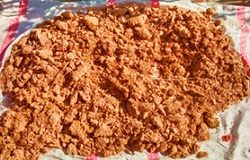Pemanfaatan Limbah Sagu Sebagai Bahan Pakan Ternak di Desa Pemakuan Laut, Sungai Tabuk, Kabupaten Banjar, Kalimantan Selatan Utilization of Sago Waste as Animal Feed Material in Pemakuan Laut Village, Sungai Tabuk, Banjar Regency, South Kalimantan
Main Article Content
Abstract
Sago plants can be used from leaves, fronds, and stems with the main product of sago starch from the stem. In the production process, the sago plants used are 7-8 years old. The productivity of sago palms in Pemakuan Laut village is around 200 kg starch/stem with a selling price of Rp. 3,500/kg in wet conditions and Rp. 7,500/kg of dry sago flour. Sago processing waste has not been utilized yet by the community even though the waste can still be used for other purposes such as animal feed, hardboard, fuel, plant growth media, and fertilizer. Sago waste is a problem in the Pemaku Laut village environment because the waste has accumulated while the location for disposing of it is limited. Therefore, in this community service activity training was carried out in making animal feed (poultry) using sago dregs. The method used is fermentation. From the activities carried out, it was known that all the participants had started to utilize sago dregs, but the preliminary process had not been carried out, the dregs were directly given to livestock. In this training, sago dregs processing is carried out using the fermentation process. From the training, it can be seen that the community already knows the process of processing the dregs before giving it livestock to increase its nutritional value.
Downloads
Article Details
Authors who publish with this journal agree to the following terms:
- Any article on the copyright is retained by the author(s).
- Author grant the journal, right of first publication with the work simultaneously licensed under a Creative Commons Attribution License that allows others to share work with acknowledgment of the work authors and initial publications in this journal.
- Authors are able to enter into a separate, additional contractual arrangements for non-exclusive distribution of published articles of work (eg, post-institutional repository) or publish it in a book, with acknowledgment of its initial publication in this journal.
- Authors are permitted and encouraged to post their work online (e.g., in institutional repositories or on their websites) prior to and during the submission process, as can lead to productive exchanges, as well as earlier and greater citation of published work.
- The article and any associated published material is distributed under the Creative Commons Attribution-ShareAlike 4.0 International License
References
Bantacut, T. 2011. Sagu: Sumberdaya untuk Penganekaragaman Pangan Pokok. Pangan. 20(1):27-40. https://doi.org/10.33964/jp.v20i1.6
Bell, A.D. 1998. Plant Form: An Illustrated Guide to Flowering Plant Morphology. Leaf Morphology: Palms. New York: Oxford University Press.
Bintoro, M.H., Nurulhaq, M.I., Pratama, A.J., Ahmad, F., Ayulia, L. 2018. Growing Area of Sago Palm and Its Environment. In: Ehara H., Toyoda Y., Johnson D. (eds) Sago Palm. Singapore: Springer. https://doi.org/10.1007/978-981-10-5269-9_2
Direktorat Jenderal Perkebunan Kementerian Pertanian Republik Indonesia. 2018. Statistik Perkebunan Indonesia 2017-2019: Sagu. Jakarta: Direktorat Jenderal Perkebunan Kementerian Pertanian Republik Indonesia.
Ehara, H. 2009. Potency of Sago Palm as Carbohydrate Resource for Strengthening Food Security Program. Jurnal Agronomi Indonesia (Indonesian Journal of Agronomy). 37(3):209-219. https://doi.org/10.24831/jai.v37i3.1255
Haedar, H., Jasman, J. 2017. Pemanfaatan Limbah Sagu (Metroxylon sago) Sebagai Bahan Dasar Pakan Ternak Unggas. Equilibrium: Jurnal Ilmiah Ekonomi, Manajemen dan Akuntansi. 6(1):5-13. http://dx.doi.org/10.35906/je001.v6i1.164
Nakamura, S., Nitta, Y., Goto, Y. 2004. Leaf Characteristics and Shape of Sago Palm (Metroxylon sagu Rottb.) for Developing a Method of Estimating Leaf Area. Plant Production Science. 7(2):198-203. https://doi.org/10.1626/pps.7.198
Nuraini. 2015. Limbah Sagu Fermentasi Sebagai Pakan Alternatif Ternak Unggas. Padang: Lembaga Pengembangan Teknologi Informasi dan Komunikasi Universitas Andalas.
Putri, A.A.K., Fatriani, F., Satriadi, T. 2019. Pemanfaatan Pohon Sagu (Metroxylon Sp) Dan Kualitas Pati Sagu Dari Desa Salimuran Kecamatan Kusan Hilir Kabupaten Tanah Bumbu Kalimantan Selatan. Jurnal Sylva Scienteae (JSS). 2(6):1083-1092. https://doi.org/10.20257/10.20527/jss.v6i3
